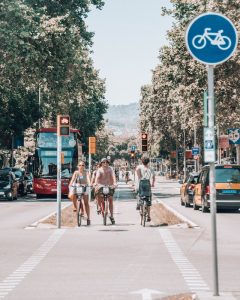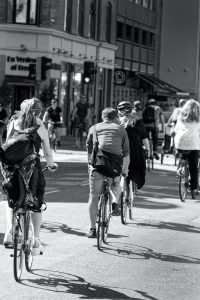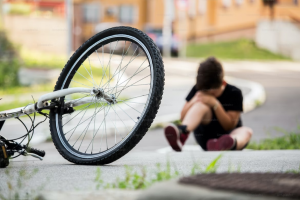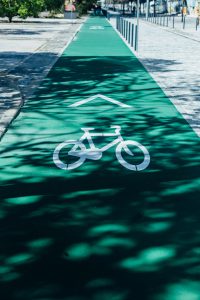What are bike lanes?
A bicycle lane is a selected area on the right-hand side of the road that bicycles have been using. Identify bike lanes using bicycle pavement markings and arrows that point bikers in the right direction. It increases the ability to move, encourages a better life, and secures the safety of city bikers by adding bike lanes to the City.
Why are bike lanes installed?
Bike lanes are being carried out on the selected path to offer several advantages, such as:
Improvement in cycling safety

- To improve safety for everybody and to help begin order on the road by giving drivers and bicycles a particular area. This lead will help the community implement parts of this law.
- Expand the use of Completed Streets as encouraged
- to increase the firmness and conduct of traffic on expressways.
- Motivate more people to bike.
How should cyclists operate in a roadway with a bike lane?
Driving or parking is not allowed in the stated place for bicyclists. Only when a vehicle is entering or leaving a driveway are they allowed to use the bike lane, which bikers cannot use for parking or driving. Also, Researchers would like to remind cyclists to strictly follow all traffic signs and signals, as well as the general laws of the road.
Use of bike lanes and their benefits
Bike lanes in city areas can be very helpful to the site. Cities are more and more looking for ways to reduce traffic while benefiting the environment, and many of these city centres are turning to bicycles. However, the introduction of shared bikes and e-bikes presents various new issues.
Bikers need to maintain their safety while biking in cities. Bike riders regularly move from sidewalk to street because there is hardly an assigned space. Because riders need to follow standard practices, this can be difficult for people walking on roads. And vehicles to manage, leading to more risky events that result in injuries and deaths.
In addition to providing cyclists with safety, specialized bike lanes secure stability in some of the behaviours of city bikers. Bike lanes reduce the need for people to walk on roads and for car drivers to correctly predict how bike riders will move along the pavement or road.
Advantages of bike lanes
Increased protection for bikers

The fact that bike lanes can increase the overall protection of many bikers worldwide is an important benefit. Specific bike lanes make riding a bike much less dangerous overall, whereas sharing a street with cars is risky. Therefore, by adding those bike lanes, the number of serious crashes would also actually decrease. Every City should believe this to protect their general residents from the accidents among vehicles and bikers that happen yearly.
will promote increased bicycle use
With the addition of bike lanes, biking will become less dangerous, increasing the chance that more people will use bicycles because they will feel safer overall. Reducing the number of vehicles on our streets is a must to cut carbon emissions and complete our climate targets. To increase bikers’ general safety and make biking more enjoyable, installing bike lanes is an important step to encourage more people to use their cycle paths more often.
You can use dedicated bike lanes to ride your bike to work.
Also, having bike lanes will make riding a bike to work even more interesting. You’ll be able to travel by bicycle much more quickly because you’ll be able to speed up more quickly and won’t have to stop as regularly.
However, cycle lanes will also be more useful as your total stress will be relatively low compared to standard streets. You can share them with vehicles, which could hurt you in the future.
Injury concerns are less of a problem for you.
Using bicycle lanes will reduce your chance of being hurt. Roads are pretty jammed, especially during peak. And bike riders are at a high risk of being eventually run over by a car, which can result in extreme injury problems and health-related harm. However, groups could lower the risk faced by bikers by using bike lanes. Also, the healthcare expenses involved with bike accidents may decrease very important, which could have a vital long-term positive impact on federal money.
reduces the attraction to using cars

In large cities, bike lanes would also reduce the interest in driving. First, more people will use bicycles instead of vehicles if they enjoy cycling more. Also, building cycle lanes will cause vehicles will have a smaller space, and vehicle operations will be more stressful. They were encouraging more people to use bicycles rather than cars.
Third, riding our bicycles instead of driving might become very beautiful. Therefore, there are many factors why bike lanes reduce the interest in driving. That is why securing our environmental targets, and long-term reduction of several harmful wastes is required.
Bikers may cause fewer problems for walkers.
Reducing biker involvement with people walking on roads will benefit from bike lanes. Now, bikers will regularly use the sidewalk rather than the vehicle lane in cities without bike lanes because they are afraid of major accidents with vehicles. Moreover, using the street for bike riding also includes a greater risk of crashes for bike riders and people walking on the streets. Using bike lanes may reduce the chance that people will be involved in collisions with bikers, reducing the risk for cyclists.
Using bike lanes could help you travel more quickly.
Users could pedal their bikes more quickly on common, so using a bike lane limits your risk of crashes with passing traffic. Bike lanes help you save time and energy in many parts of your ordinary routine, especially if you’re in a rush and must arrive at an important meeting on time.
It’s beneficial for visitors who wish to visit the City.

Foreign visitors may find bike lanes valuable as they discover a town. Several more visitors use bus services or other transportation forms to explore cities. Bike lanes, moreover, significantly boost the attraction for tourists to go for some reasons since there are several perks to exploring a town by bike. Adding bike lanes is a helpful way to improve the experience of tourists in a city.
improved air quality
Also, since the addition of cycle paths may reduce our need to drive, the pollution levels in city areas would hugely improve. As a result, there would be a big drop in the risk of developing serious health issues linked to poor air quality, increasing the overall survival rate. And because of this, bike lanes must be a great idea from both a wellness and pollution levels perceptive.
fewer contaminant particles

As there won’t be nearly as many emissions from diesel vehicles, cycling will also reduce particle carbon emissions significantly. Air pollutants are a major threat to our health because they can lead to severe diseases like respiratory system cancer and asthma. Adding bike lanes and reducing our vehicles’ use would be highly helpful in avoiding those issues.
possibly reducing global warming
Cycling could significantly reduce our overall carbon dioxide emissions due to a low need for automobiles due to bike lanes’ construction. As a result, it is also possible to slow up worldwide warming. We must do everything within our impact to reduce greenhouse emissions worldwide since climate change has become one of society’s most important health issues.
Disadvantages of bike lanes
 Even if using bicycle lanes may have several uses, are several drawbacks also.
Even if using bicycle lanes may have several uses, are several drawbacks also.
less room for vehicles
Due to the bike lanes, there will be less room for vehicles on our streets. People who travel by automobile are much more likely to be stressed and have a higher chance of being in a car crash. Bike lanes may reduce the stress for cyclists, but they may increase tension for drivers of motor vehicles.
The focus of motorists may also decrease.
Car drivers’ have inadequate knowledge of the likely threats. They can represent that cyclists may also decline along with their attention to traffic and the risk presented by bikers.
For example, if a cycle lane stops, a biker may go from the cycle lane to the regular street. If vehicle drivers are unaware of this risk, multiple deadly crashes will likely occur over the long term.
Road users can become irritated.
Car drivers might find particular bike lanes to be relatively easy. While traffic may catch many drivers in traffic, cyclists can use allocated bike lanes and are often faster than automobiles. As a result, car owners’ general frustration levels could rise adequately, increasing violent behavior.
In other places, it might be optional.
Although adding bike lanes may be helpful. It may be optional for some places where crashes between cars and bicycles are common. However, there will be a little problem between vehicles and bikes in other areas. Needing bike lanes for a particular city must be decided by the politicians.
A small percentage of people use bicycles.
Only a tiny percentage of ordinary people use bikes to travel around in many cities worldwide. So adding bike lanes could not be helpful since people would continue to use their bikes very often. People prefer to avoid riding their bicycles to get around for several reasons that aren’t safe.
Bike lanes may be expensive.
In addition to building bike lanes, it can be labour-intensive to develop those lanes. It is up to governments and communities to decide whether the costs connected with building bike lanes are fair.
Above, we discussed the advantages and disadvantages of using a bike lane. Sometimes these bike lanes are closed for construction purposes or as a part of infrastructure support.
Bicycling in construction zones
The City’s bicycle routes are attended mainly by people who bike, skateboard, and rollerblade; they should be securely helped through and around construction zones. Bikers are unlucky people who have very little safety from accidents and falls. Construction on bicycle routes needs special consideration and care. To keep the cyclists safer during the construction process, the below suggested bikers can use other choices instead of a bike lane.
Protected lanes
Protected lanes, also known as cycle tracks. It is a physical barrier, like fences or planters, to separate cyclists from vehicles. Protected lanes help to process the construction work effectively.
Green Bike Lanes
Green cycle lanes are concrete sidewalks with differentiations. If widely using the green bike lane to show when cars drive into or pass along a bicycle lane. In these places, bike lanes are green. As it gains attention and improves safety by warning drivers, they must give through bicycles.
Warning Bike Lanes
Using a regular bike lane equals an advisory road on narrow, limited streets. Also, on the right, beside stopped cars, they are labelled with only a solid white line. Whereas on the left, it will be a trendline marking. These markings provide space for bikers to ride, but they are also open to drivers in case they need to cross oncoming vehicles. When a bike lane is advisory, drivers of other vehicles are permitted to join it to intercept incoming driving securely. As a result, riders must be more prepared than they would be in a standard bike lane. In case a driver decides to use the advisory bike lane.
padded bike lane
Like a standard bike lane, a secured bike lane has a labelled barrier dividing it from the nearby travel lanes. Building a buffered cycle lane allows riders more room for movement and increase safety. The cycle lane and the traffic lane are divided by the buffer. White directional arrows may mark the buffer to signal that no vehicle is allowed there.
Except when cars have to drive, access, or exit the road, a separate bike lane is only open to bike riders. If a bicycle is coming, drivers must stop and let riders pass. if not, they need to use a cycle lane to make a turn. The same rules apply to other bike lanes and offset bike lanes. When entering or leaving a secured bike lane, riders must notice and give to automobiles in the nearby traffic lanes.
Signs and symbols related to bike lanes
Rumble strips and shoulders(borders)
The shoulders on the road directly go along the roadways. It has to change stopped vehicles, using only in case of an emergency. Although it’s technically allowed, bicycles aren’t needed to ride on borders. It is important to remember that walls could be more well protected as transport paths or may have been too wide for safe riding. However, they are often the safest location to travel, especially on roadways with high rates of speed or traffic. Rumble strips are a security measure for reducing pass accidents included in borders.
Roundabouts
Roundabouts Cyclists and people walking in streets must position themselves in the driving lane (“take a lane”). Using them the same way as a driver improves visibility and avoids dangerous crossing.
Boulevard Bikes
A lane designed and built, especially for bicycle traffic is known as a bike boulevard. Building a bike boulevard is to make riding safer and more enjoyable for cyclists—especially those who don’t feel safe riding on busy streets. A cycle boulevard goes above and above to secure safer crossings at major roadways and enables drivers to go at decent speeds. It reduces the number of stop signs, even if many residential routes are already friendly to most bikers. Several traffic-calming and design features, including speed bumps, roundabouts, pavement additions, joining, and traffic lights, help to produce this environment.
Many changes, especially the joining treatments, increase both the safety of drivers and people walking on the streets. Bikers can identify pavement markers with the text “BLVD” and a large bicycle symbol bike boulevard.
In conclusion, since we are aware of the guidelines and the uses of bike lanes. We can now safely travel using a bicycle.
